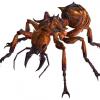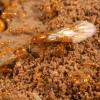- Formiculture.com
- Forums
- Gallery
- Members
- Member Map
- Chat

What is the ideal temperature?
Started By
Foogoo
, Nov 4 2014 9:47 PM
14 replies to this topic
#1
 Offline
-
Posted November 4 2014 - 9:47 PM
Offline
-
Posted November 4 2014 - 9:47 PM
Specifically for Pogonomyrmex and camponotus? I'm using a heating pad in hopes of getting them to grow, but I don't want to roast them either!
Camponotus vicinus, Crematogaster 1, Crematogaster 2, Formica francoeuri, *, *, Myrmecocystus testaceus, Novomessor cockerelli, Pheidole hyatti, Pogonomyrmex californicus, Pogonomyrmex rugosus, Solenopsis invicta
#2
 Offline
-
Posted November 4 2014 - 10:00 PM
Offline
-
Posted November 4 2014 - 10:00 PM
Pogonomyrmex californicus bicolor is a desert species, so consider really warm in the day, and then a steadier temperature at night. (The temperature is almost constant underground however.) As for Camponotus, depending on where they were collected, they should have a hibernation period, and other than that just nice room temperature. As for heating in hopes of speeding brood development, I am not the person to ask. ![]()
#3
 Offline
-
Posted November 5 2014 - 9:59 AM
Offline
-
Posted November 5 2014 - 9:59 AM
I have kept a lot of my ants at around 85 to 90 degrees, and I get some pretty fast growth. I don't do this on purpose, because I'm not sure if some of them like Camponotus should be kept that warm, but that's just the temperature my apartment stays at through the summer time... it's miserable. Like Greg basically said, consider their natural environment, and take an average of the high and low temperatures, and you will probably have the temperature of their nest under ground.
#4
 Offline
-
Posted November 5 2014 - 11:21 AM
Offline
-
Posted November 5 2014 - 11:21 AM
Hmm interesting. I guess my actual question is: should I bother with a heat lamp/heat source? In the wintertime, it can get down to the 60's even 50's overnight if I don't have the heater on (which I rarely do). Would it stress the colonies if I artificially boosted them to the 80's? Or do they need a rest/hibernation period, even in SoCal?
Camponotus vicinus, Crematogaster 1, Crematogaster 2, Formica francoeuri, *, *, Myrmecocystus testaceus, Novomessor cockerelli, Pheidole hyatti, Pogonomyrmex californicus, Pogonomyrmex rugosus, Solenopsis invicta
#5
 Offline
-
Posted November 5 2014 - 11:28 AM
Offline
-
Posted November 5 2014 - 11:28 AM
I really don't know. I would imagine that the closest conditions are to those in their natural environment, the better they will do. Obviously, if you want to heat them, then you can probably get brood to grow faster, but I know species that need to be hibernated will do significantly worse if they are kept warm, and some won't produce at all. In the high desert, it gets pretty cold during the winter, but I haven't heard of anyone hibernating desert species. Who knows, maybe they might do better if they were "hibernated" (somewhere around 55 F to 60 F), since that is what they normally experience. Since I don't have a way of perfectly regulating my refrigerator's temperature, and I don't have one for each habitat, it's always going to be in the low to mid 40's F, so that average I think would mostly match the hibernating temperatures of high elevation mountain species (here in So Cal). For this reason, I am only hibernating species I find way up in the mountains where there is snow on the ground for a good portion of the winter.
If anybody has any better ideas let me know.
#6
 Offline
-
Posted November 5 2014 - 12:26 PM
Offline
-
Posted November 5 2014 - 12:26 PM
I really don't know. I would imagine that the closest conditions are to those in their natural environment, the better they will do. Obviously, if you want to heat them, then you can probably get brood to grow faster, but I know species that need to be hibernated will do significantly worse if they are kept warm, and some won't produce at all. In the high desert, it gets pretty cold during the winter, but I haven't heard of anyone hibernating desert species. Who knows, maybe they might do better if they were "hibernated" (somewhere around 55 F to 60 F), since that is what they normally experience. Since I don't have a way of perfectly regulating my refrigerator's temperature, and I don't have one for each habitat, it's always going to be in the low to mid 40's F, so that average I think would mostly match the hibernating temperatures of high elevation mountain species (here in So Cal). For this reason, I am only hibernating species I find way up in the mountains where there is snow on the ground for a good portion of the winter.
If anybody has any better ideas let me know.
I just coincidentally read your Camponotus journal. Maybe I should do the same with them once the eggs have hatched and grown up.
Camponotus vicinus, Crematogaster 1, Crematogaster 2, Formica francoeuri, *, *, Myrmecocystus testaceus, Novomessor cockerelli, Pheidole hyatti, Pogonomyrmex californicus, Pogonomyrmex rugosus, Solenopsis invicta
#7
 Offline
-
Posted November 5 2014 - 1:18 PM
Offline
-
Posted November 5 2014 - 1:18 PM
I think as long as they have turned to larvae, it's okay to hibernate them. Just make sure they don't make it all the way to pupae before you get around to doing it.
#8
 Offline
-
Posted November 5 2014 - 1:25 PM
Offline
-
Posted November 5 2014 - 1:25 PM
I think as long as they have turned to larvae, it's okay to hibernate them. Just make sure they don't make it all the way to pupae before you get around to doing it.
What about waiting until they all eclose? What I'm getting is larvae are ok to refrigerate but pupae and eggs are not?
Camponotus vicinus, Crematogaster 1, Crematogaster 2, Formica francoeuri, *, *, Myrmecocystus testaceus, Novomessor cockerelli, Pheidole hyatti, Pogonomyrmex californicus, Pogonomyrmex rugosus, Solenopsis invicta
#9
 Offline
-
Posted November 5 2014 - 2:23 PM
Offline
-
Posted November 5 2014 - 2:23 PM
That's correct as far as I know. You can wait for them to eclose, but you might have more eggs and larvae by then.
#10
 Offline
-
Posted November 18 2014 - 11:57 PM
Offline
-
Posted November 18 2014 - 11:57 PM
I put all my camponotus in the refrigerator today. What's interesting is that all but one had any eggs or cocoons. All the larvae has been growing really slowly almost as if they were somehow doing this on purpose anticipating winter. Pupae and eggs cannot survive the cold from what I understand. As for my Pogonomyrmex I blast a heat lamp on them all day and shut it off at night. The temp is 85-90 at least fifteen hours a day
Sent from my iPad using Tapatalk
Sent from my iPad using Tapatalk
#11
 Offline
-
Posted November 19 2014 - 7:00 AM
Offline
-
Posted November 19 2014 - 7:00 AM
Quite a few northern species where I am over winter their larvae. The larvae literally stop growing until they get enough of a cold snap (the time varies by species).
I have found my Camponotus to do this, but it is most noticeable with my Lasius. In an experiment once, I left the colony on the heat cable for 9 months (our summer is usually 4 months), for 5 months the larvae did not develop - I put them in the fridge as I did not want to harm them.
I have never seen any of my Formica overwinter any kind of brood.
"Always do right. This will gratify some people, and astound the rest." -- Samuel Clemens
#12
 Offline
-
Posted November 19 2014 - 5:29 PM
Offline
-
Posted November 19 2014 - 5:29 PM
Ok so my observations may be correct
Sent from my iPad using Tapatalk
Sent from my iPad using Tapatalk
#13
 Offline
-
Posted November 20 2014 - 11:11 AM
Offline
-
Posted November 20 2014 - 11:11 AM
I have a few species that are not found exclusively in the mountains where it snows and gets really cold, but some of them seem like their larvae just aren't growing much. I am starting to wonder if any species from anywhere but the tropics would benefit from a brief cold spell. Even in Southern California, it gets down into the 40's quite often at night, and even into the 30's a few times every winter. In my apartment, the temperature NEVER goes below 70 degrees. It seems to me, putting my non-high-elevation ants in the fridge for a day or two or even a week would be much more similar to their natural environment. I think I might try this and see if it helps. I also have some species that I'm not really sure about, so I'll be putting some in the fridge, and leaving some out. Hopefully this will produce some noticeable differences.
#14
 Offline
-
Posted November 22 2014 - 10:08 PM
Offline
-
Posted November 22 2014 - 10:08 PM
I have a question. Do crematogasters need a heating cable in room temperatures?
Remember Dragon Warrior, anything is possible when you have inner peace. - Master Shifu
Current Queens:
1 Unknown Pogomyemex
1 Solenopsis Xyloni
Current Queens:
1 Unknown Pogomyemex
1 Solenopsis Xyloni
#15
 Offline
-
Posted November 22 2014 - 11:15 PM
Offline
-
Posted November 22 2014 - 11:15 PM
I have a question. Do crematogasters need a heating cable in room temperature
I've never used a heat cable but my young crematogaster colony is doing way better since I gave them temps of 86F
0 user(s) are reading this topic
0 members, 0 guests, 0 anonymous users

















